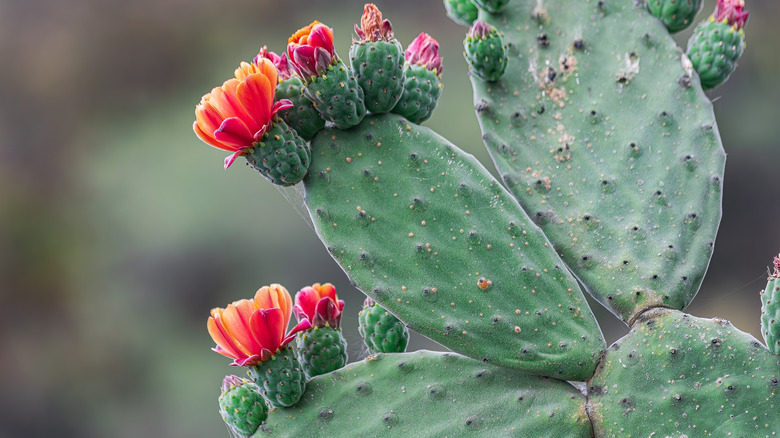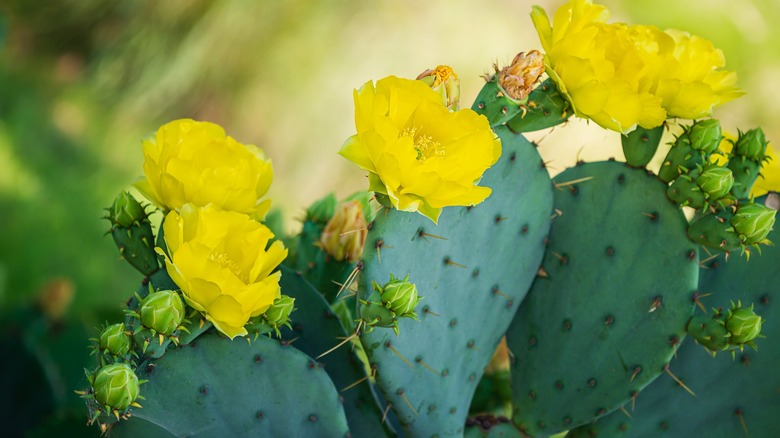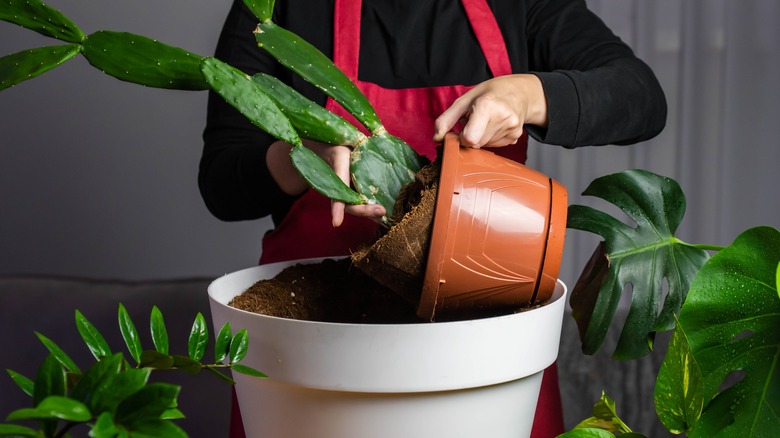How To Grow A Prickly Pear Cactus For Gorgeous Colorful Flowers
The prickly pear cactus (Opuntia) is a massive genus with over 150 known species of paddle-shaped cacti that produce gorgeous flowers. Depending on the variety, the colors may be bright shades of pink, red, orange, or yellow. One of the most popular is the eastern prickly pear cactus (Opuntia humifusa), known for its vibrant yellow blooms that appear atop the pads at the beginning of summer. If pinkish flowers are more your style, the beavertail cactus (Opuntia basilaris) is a grayish-blue shrub that produces rose-colored blooms around late spring. No matter what you're looking for, there's a perfect fit for your garden.
These stunning cacti are some of the easiest houseplants anyone can keep alive and don't typically have issues with pests or diseases. Not only is this plant non-toxic, this Mexican-native species is a common food source via its edible fruit and pads. Although it's generally safe for consumption when properly prepared and is not poisonous to humans or pets, you should still be cautious. Nearly all species have defensive spines, which can be harmful if a small child or animal attempts to touch or ingest them. While you'd think the spines would ward off most animals, these plants make a nutritious snack for wildlife like rabbits, deer, and tortoises. Birds are also fond of this species, eating the nectar, berries, and seeds it produces. The showy blooms also attract various bees, making this the perfect cactus for anyone who wants to start a pollinator garden.
What conditions the prickly pear cactus needs to thrive
If you want to enjoy the colorful flowers the prickly pear cactus has to offer, you'll want to make sure you're providing the proper care. Luckily, growing and caring for the prickly pear cactus is simple enough that even a beginner gardener can handle it. As part of one of the largest genera of cacti you can grow that bloom with beautiful flowers, there's a stunning variety for nearly everyone's tastes. It's not just about its good looks, though — this hardy plant is also known for its resilience to harsh conditions. Being desert-growing members of the cacti family, they're extremely drought-tolerant and hardly ever need watering once established.
Care requirements can range from species to species, though the basics are generally the same: They prefer a sunny spot and dirt that doesn't stay too moist. You should only water these plants every two to three weeks or once the soil has completely dried out; even minimal rainfall is enough to keep these plants happy. Aside from needing well-draining soil, they thrive in several soil types, from sandy to clay and acidic to alkaline. West- or south-facing windows are preferable when growing indoors to ensure they get at least six hours of daily sunlight. When growing outside, an area where they can get protection from the hot afternoon sun can help keep them from getting burnt. If your plant isn't blooming, it may need a balanced fertilizer during the growing season.
Where to grow prickly pear cactus
With hardiness zones ranging from 4 to 11, you can grow a prickly pear cactus outdoors nearly anywhere in the United States. For example, the brittle prickly pear cactus (Opuntia fragilis) is one of the most cold-hardy varieties and can thrive in zones as low as 4, meaning it can withstand temperatures as low as -30 degrees Fahrenheit. So, as long as you choose a species that's hardy in your region, you won't need to do anything extra for overwintering. However, if you're in an area that gets harsh winters, you can bring warm-weather cacti inside once the temperatures drop down. This is also the time of year when you should start pruning if you want to control the size. You can even grow new plants by propagating the pad cuttings.
These unique cacti are perfect for your indoor space as well, so you can leave them inside all year if that's what you'd prefer. When growing in pots, choose a container that has plenty of drainage holes so water doesn't pool up around the roots. Shallow and wide planters are the best choice, as these sprawling growers can get a bit top-heavy. Repotting is necessary once the plant becomes rootbound or if you need a more stable base to manage new growth. Depending on the variety, protective gloves may be required to avoid getting stuck by one (or many) of the spines.


